The Moons of Jupiter

All of these worlds are yours, except Europa. Attempt no landings there.
At last count, there were sixty-three of them, of which 49 are named. Many of these have only been found in the last decade. They are all named after Zeus's lovers and descendants, so you can tell he really got around.
The first four to be found (Io, Europa, Ganymede and Callisto) were discovered by Galileo himself and thus are called the Galilean Moons. He wanted to name them after his patrons, the Medicis, but later generations of astronomers thought otherwise. The same night Galileo discovered them, a German by the name of Simon Marius -- who'd independently gotten the idea of pointing a telescope at the heavens -- also saw the same 4 moons, and named them after four of Jupiter's lovers from Classical Mythology; it's these names that are still in use today.
The innermost moons (Metis, Adrastea, Amalthea, Thebe)
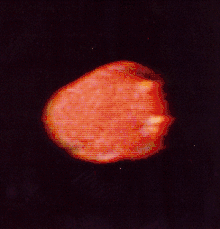
Four irregular shaped moons, being pretty small and not large enough to form into spheres. Due to tidal forces, the first two will eventually drop into the planet or break up into ring particles. The largest, Amalthea, was discovered in 1892 and is very, very red. The radiation levels this close to Jupiter will kill you faster than you can say "non-functional DNA".
Amalthea didn't get its name until the mid-20th century; before then it was simply known as "Jupiter V" (as in the Roman numeral 5). Arthur C. Clarke wrote a short story by this name, which posited an alien civilization there. (How a civilization could form under such high radiation levels, in surface gravity only 0.2% of Earth's, is another matter.)
Space Pizza: Io
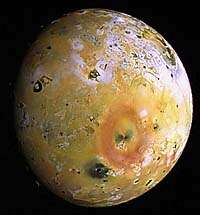
About 3640km in diameter, Io is one of the Galilean moons.
Because of the pull of Europa and Ganymede, Io suffers from huge tidal forces, resulting in constant volcanic eruptions jutting out hundreds of kilometers into space. The colourful surface, resembling a pizza due to massive deposits of sulfur, is constantly changing as a result. Most of the material in Jupiter's magnetosphere comes from Io's volcanoes, including the radiation belts and a gas and plasma ring near Io's orbit; as Io's surface gravity is only 18.3% as strong as Earth's, its volcanic gases can easily reach escape velocity. The radiation levels (3600 rem/day)this close to Jupiter as a result will kill you, but you'll have a few hours to savor the unfairness of it all before your nervous system collapses.
Its surface features are named after gods of fire, thunder and lightning, the sun or blacksmithing (Ra Patera, the volcanoes Pele and Surt, etc.) Given its extreme geological activity, it's questionable how long any of these surface features will last.
Io was the setting for the movie Outland.
Ice World: Europa
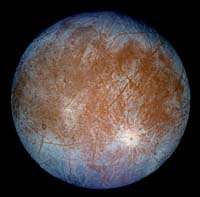
Just smaller than our Moon, Europa is covered by a cracked, frozen ocean (smoother than a billiard ball would be if it was the same size) and has a tenuous atmosphere (on earth it would be considered a pretty decent vacuum). It may support simple life under the surface. Here the radiation levels (540 rem/day) are less, so you'll have up to a week or so to get your affairs together. Attempt no landings here. However, the ocean under the ice is considered a good place to colonize, with the thick ice crust protecting from radiation.
Its surface features are named after places and myths of the Celtic mythos (Tara Regio, the crater Pwyll, etc.). Surface gravity is 13.4% of Earth's.
As shown in the page quote, Europa played a prominent role in 2010: The Year We Make Contact.
Big Brother: Ganymede
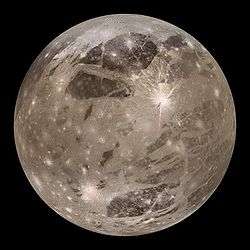
The largest moon in the Solar System. Larger than Mercury, it could count as a planet if on its own if it weren't already attached to one. Its surface shows evidence of past geological activity. A popular sci-fi setting, even if it is really just a bigger version of our Moon, in other words, deader than tanktops. The radiation here (8 rem/day) won't kill you directly, but you might want to invest in a surrogate gamete donor (those eggs and sperm cells spoil easy!) or an MRI machine (so you can get a cancer scan every six months or so). Also has an under-ice ocean which is probably good for colonization, but the ice crust is thicker, perhaps too thick to drill.
Despite being larger than Mercury, Ganymede isn't as dense. It's less than half of Mercury's mass, and its surface gravity is only 14.6% of Earth's. (Mercury, by contrast, has 38% of Earth's surface gravity, the same as the surface gravity on Mars.)
Its surface features are named after locations and myths of Ancient Egypt and Mesopotamia (Tiamat Sulcus, Memphis Facula, etc.). Many of these features are tectonic, possibly formed by tidal heating or by expansion of the moon. Most features, tectonic or crater, appear to have formed several billion years ago over roughly the same time.
It is the only moon known to produce its own magnetic field.
Bullseye: Callisto
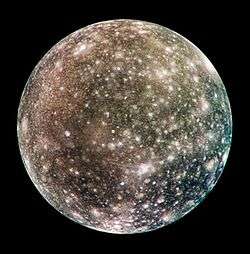
Almost as big as Mercury and the third biggest moon in the Solar System, this dead world is outside the main radiation belts of Jupiter and is the outermost Galilean moon. At larger scales it's covered by draters on top of other craters. At smaller scales, the surface shows more variety, with plains and knobs, probably formed by the erosion of yet more craters. The general calmness of the place (0.01 rem/day average) makes it a good location to colonise, but most writers tend to ignore it.
Its surface features are named after elements of northern myths (Valhalla Basin, the crater Bran, etc.). Surface gravity is 12.6% of Earth's.
The Rest Of The Mess (Themisto, Leda, Himalia, Lysithea, etc.)
Also known as irregular satellites, they're believed to be captured asteroids and are probably not permanently attached to Jupiter. They're grouped into 4 separate families (except for three ungrouped outliers) based on their orbits, and they all stay far away from the big guys in the middle.